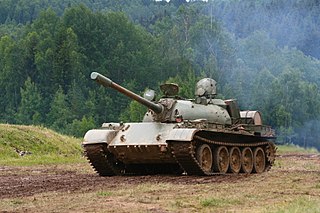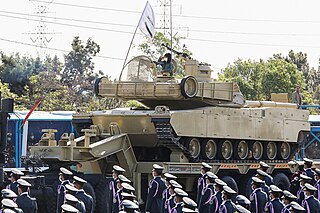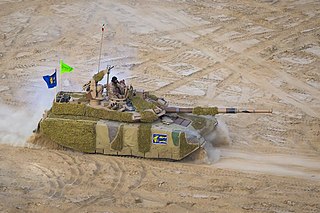
The T-54 and T-55 tanks are a series of Soviet main battle tanks introduced in the years following the Second World War. The first T-54 prototype was completed at Nizhny Tagil by the end of 1945. From the late 1950s, the T-54 eventually became the main tank for armoured units of the Soviet Army, armies of the Warsaw Pact countries, and many others. T-54s and T-55s have been involved in many of the world's armed conflicts since their introduction in the second half of the 20th century.

The T-62 is a Soviet medium tank that was first introduced in 1961. As a further development of the T-55 series, the T-62 retained many similar design elements of its predecessor including low profile and thick turret armour.

The Type 59 main battle tank is a Chinese-produced version of the Soviet T-54A tank, an early model of the ubiquitous T-54/55 series. The first vehicles were produced in 1958 and it was accepted into service in 1959, with serial production beginning in 1963. Over 10,000 of the tanks were produced by the time production ended in 1985 with approximately 5,500 serving with the Chinese armed forces. The tank formed the backbone of the Chinese People's Liberation Army armoured units until the early 2000s, with an estimated 5,000 of the later Type 59-I and Type 59-II variants in service in 2002.

The Type 69 and Type 79 are Chinese first generation main battle tanks. Both were developments of the Type 59 medium tank with technologies derived from T-62. They were the first indigenously developed main battle tanks by China, although also classified as medium tanks while in development and service. Their lineage from the T-54A can be seen through the distinct gap between the first and second road wheels. Other improvements included a new engine, ballistic computers, and laser rangefinders. The more advanced Type 79 variant was equipped with a 105 mm rifled gun which was also found on the Type 80 tank.

The Type 90 tank is a main battle tank (MBT) of the Japan Ground Self-Defense Force (JGSDF). It was designed and built by Mitsubishi Heavy Industries as a replacement for the Type 61 and to supplement the then current fleet of Type 74 tanks, and entered service in 1990.

The Type 96 or ZTZ96 is a Chinese second generation main battle tank (MBT). The final evolution of the Type 88 design, the Type 96 entered service with the People's Liberation Army (PLA) in 1997. The later variants of the Type 96 are currently in PLA service together with China's third generation MBT, the Type 99.

The FV4201 Chieftain was the main battle tank of the United Kingdom during the 1960s–1990s.

The Royal Ordnance L7, officially designated Gun, 105 mm, Tank, L7, is the basic model of the United Kingdom's most successful tank gun. It is a 105 mm L/52 rifled design by the Royal Ordnance Factories, intended for use in armoured fighting vehicles, replacing the older QF 20-pounder (84 mm) gun mounted on the British Centurion tank. The successful L7 gun has been fitted on many armoured vehicles, including the Centurion, the German Leopard 1 and, in an altered design, as the M68 gun in several variants of the US M48 Patton and M60.

Zulfiqar (ذوالفقار) is an Iranian main battle tank, conceived by Brigadier General Mir-Younes Masoumzadeh, deputy ground force commander for research and self-sufficiency of the armed forces. It is named after Zulfiqar, the legendary sword of Ali, the fourth Caliph and the first Shiite Imam. It's also known as Zolfaqar.

The T-54/T-55 tank series is the most widely used tank in the world and has seen service in over 50 countries. It has also served as the platform for a wide variety of specialty armoured vehicles.

The Military Industry Corporation is the state-run defense corporation of Sudan. It is responsible for the production of a wide range of defence equipment, such as munitions, firearms, artillery etc.

A main battle tank (MBT), also known as a battle tank or universal tank, is a tank that fills the role of armor-protected direct fire and maneuver in many modern armies. Cold War-era development of more powerful engines, better suspension systems and lighter composite armor allowed for the design of a tank that had the firepower of a super-heavy tank, the armor protection of a heavy tank, and the mobility of a light tank, in a package with the weight of a medium tank. The first designated MBT was the British Chieftain tank, which during its development in the 1950s was re-designed as an MBT: "Chieftain, which until then had been called Medium Gun Tank No 2, was renamed the Main Battle Tank". Through the 1960s and 1970s, the MBT replaced almost all other types of tanks, leaving only some specialist roles to be filled by lighter designs or other types of armored fighting vehicles.

This article on military tanks deals with the history of tanks employed by various military forces belonging to the Kuomintang and Chinese Communist Party (CCP) within China. From the early half of the 20th century, tanks were initially obtained from other countries; eventually indigenously designed Chinese tanks started manufacture and became used during the Cold War and towards the modern era.

The Al-Zarrar, is a second generation main battle tank (MBT), currently in the services of the Pakistan Army since 2004. The tank is named after Muslim warrior Zarrar bin Al-Azwar.
Yarmouk Military Industrial Complex (YIC), also known as the Yarmouk Munitions Factory, is a military complex located in Khartoum, the capital of Sudan. The complex was established in 1993 and inaugurated in 1996 with the aim of establishing advanced military industries to meet defence needs in Sudan and contribute to the transfer and localisation of modern technology and benefit from it in the field of defence. It produces rifles, pistols, launcher cannons and tanks such as Al Basheer MBT , Al Zubair 1 MBT, and Al Zubair 2 MBT, as well as Amir IFV and Amir 2 IFV armoured vehicles and self-propelled guns, as well as ammunition of various kinds.
The post–Cold War era is the period in world history from the collapse of the Soviet Union on December 27, 1991 to the present. During the Cold War, the Soviet domination of the Warsaw Pact led to effective standardization on a few tank designs. In comparison, France, Germany, the United States, and the United Kingdom had previously developed their own tank designs, but now tried to standardize their designs, while the smaller nations of NATO purchased or adapted these designs.

The Karrar is an Iranian main battle tank. The tank was announced in 2016. At the announcement, it was stated that it possessed an electro-optical fire control system, a laser rangefinder, ballistic computer and could fire at both stationary and mobile targets in day or night.

Tanks have been utilized in Iraq both within the military and within several conflicts with their usage and origin after World War II; the Cold War; and the modern era. This includes imported Soviet tanks as well as British designs imported after World War II, and current American ones.

The Type 59G Durjoy, sometimes known as Type 59G, is a highly modernized version of the Chinese Type 59 tank for the Bangladesh Army. The Bangladesh Army's old Type 59 tanks were upgraded similarly to Type 59G standard at 902 Central Workshop of the Bangladesh Machine Tools Factory with Chinese assistance.


















